Are All Collets Created Equal?
In the world of machining, traditional collets have long been the go-to solution for holding various tool diameters within a tool holder. If you have worked on a CNC machine, you have almost certainly encountered these and know that while they can be effective, traditional collets come with certain limitations that can impact performance. Sometimes the tools seem to pull out of the collet, and other times it can cause tool failure during an important junction. Are we simply stuck with these collets since they're "good enough?"
HAIMER claims to have a better alternative -- the Shrink Fit Collet System, an innovative approach designed to address these shortcomings and enhance machining efficiency. HAIMER is very proud of their solution to the challenges faced with the traditional collet.
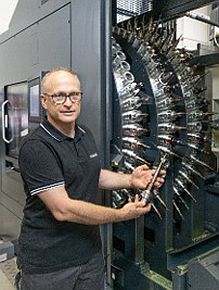
Haimer's Head of Machining Manfred Mayr
Manfred Mayr, Head of Machining at HAIMER in Germany, explains: "HAIMER Shrink Fit collets have been a game-changer for our production. Compared to traditional ER collets, we've seen a significant boost in machining accuracy and reliability. The elimination of tool pullout and the consistent performance under high-precision conditions have allowed us to reduce downtime and improve overall efficiency."
Well, the team at the Oregon Manufacturing Innovation Center, Research and Development (OMIC R&D) decided it was time to put them to the test.
The following is their reporting -- in their own words.
In our latest study, we took on the task of evaluating the capabilities of HAIMER's Shrink Fit Collet System compared to the more traditional ER32 collets. Our objective was clear: to provide unbiased, factual reporting based on rigorous testing, helping machinists understand the practical differences between these two systems.
Setting the Stage
Our testing began with machining operations conducted on the Doosan Puma TT2500SY, a workhorse known for its robust nature and ideal for this type of comparative study. We selected three sizes of collets for the test: 1/4", 3/8", and 1/2" diameter collets for both the Shrink Fit ER32 and traditional ER32 systems.
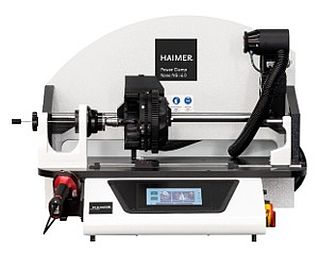
The HAIMER Powerclamp Nano NG i4.0
The first step in our analysis involved setting up all Shrink Fit collets on the HAIMER Power Clamp Nano NG i4.0. The setup times for each collet system were recorded to provide as many insights into efficiency as possible.
HAIMER's Shrink Fit Collets required an average of one minute and 35 seconds to set up using the Heat Shrink machine, plus an additional 30 seconds to secure them in the holder. In comparison, traditional ER32 collets took an average of one minute and 18 seconds to set up directly in the machine. While the traditional ER32 collets had a slightly quicker setup time, it's important to note that the HAIMER Shrink Fit Collet holders can be pre-set offline. This feature can significantly streamline the machining process by reducing downtime.
With design approval from HAIMER, OMIC R&D created a facsimile part to put both collet systems to the test. We wanted to make sure this test would incorporate as many different surfaces as we could to get a full picture of how these collets would compare. This part included various features such as Flats, Open and Closed Side Pockets, and Face Pockets, each requiring those different endmill diameters (1/2", 3/8", and 1/4", respectively).
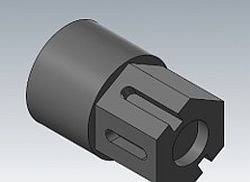
Facsimile part design
We created four identical parts that were going to be used with each of the endmills. For the material, we used four-inch diameter 4140 steel workpieces, prepped and provided by OMIC R&D. This choice of material ensured consistency and reliability in our testing conditions.
Traditional Collets
When using traditional ER32 collets, we encountered several challenges that will likely be recognizable.
Tool pullout was a consistent issue during the machining of Flats. This phenomenon, where the tool slips out of the collet during operation, can severely impact machining accuracy and surface finish. Similarly, when machining the Side Pockets, tools exhibited movement within the collet system, both pushing and pulling, leading to inconsistencies.
The Face Pocket operations further showcased the limitations of traditional ER32 collets. While one part was successfully machined, another exhibited tool movement, resulting in inaccuracies. During the machining of parts 1 and 2, tool pullout was frequent, with the maximum observed pullout reaching 0.2304". Horsepower draw during these operations was inconsistent, reflecting the unstable nature of tool engagement.
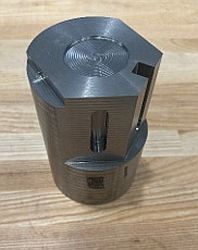
Facsimile part failure when using traditional ER32 collet
The most severe incident resulted in a tool breaking mid-cut, forcing the test to come to a halt and underscoring the potential risks associated with this collet system.
Taylor Schaming, one of our Associate Manufacturing Solutions Researchers, noted, "Traditional ER32 collets are usually pretty reliable in many standard applications, but this shows the risk. The frequent tool pullout and this break just goes to show the need for a better solution."
The Shrink Fit Alternative
In stark contrast to the traditional models, the Shrink Fit ER32 Collets demonstrated exceptional performance.
No tool pullout was observed during the machining of Flats, and all features were consistently machined successfully across two parts, totaling 12 Flats. The Side Pockets were equally impressive, with no signs of unfavorable tool movement. The dimensions matched the design specifications perfectly, and the surface finish was of high quality.
Face Pocket operations with Shrink Fit Collets were equally successful, with no tool movement observed. The parts were machined accurately to their designed dimensions, showcasing the stability and precision of this collet system.
Overall, during the machining of parts 3 and 4, there were no instances of tool pullout or pushing whatsoever. The horsepower drawn was more reliable and repeatable with the Shrink Fit Collets, indicating a stable and consistent machining process. The maximum deviation of features was a mere 0.003", with the majority of deviations being less than 0.001".
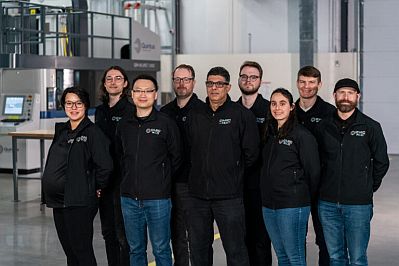
OMIC R&D is maintained by people who see roadblocks as an opportunity to find another path. Their on-site researchers have years of hands-on industry experience and are not bound by past practices.
Summary of Findings
While we cannot share the entirety of the data recovered from this project, our comprehensive testing revealed clear differences in performance between traditional ER32 collets and HAIMER's Shrink Fit Collet System.
Traditional Collets: Parts 1 & 2
- Flats: Consistent tool pullout
- Side Pockets: Tool movement (pushed and pulled) within the collet system
- Face Pocket: Inconsistent performance; one part machined successfully, another exhibited tool movement
- General Observations: Frequent tool pullout and pushing, maximum tool pullout of 0.2304", tool breakage mid-cut, inconsistent horsepower draw
Shrink Fit Collets: Parts 3 & 4
- Flats: No tool pullout; consistent successful machining
- Side Pockets: No unfavorable tool movement; dimensions as designed with a good finish
- Face Pockets: Accurate machining to designed dimensions; no tool movement
- General Observations: Reliable and repeatable horsepower draw, no instances of tool pullout or pushing, maximum deviation of 0.003", majority of deviations less than 0.001". The Shrink Fit Collets are easier for an operator to install due to no longer focusing on the proper tool stick out or loss of tool during setup.
The findings from this study provide a clear and factual comparison between traditional ER32 collets and HAIMER's Shrink Fit Collet System.
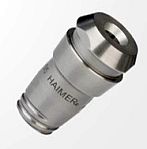
Haimer Heat Shrink Collet
While traditional collets offer ease of use and marginally quicker setup times, they exhibited significant tool movement and pullout, affecting machine accuracy and consistency. This can be an enormous risk when working on expensive materials. On the other hand, the HAIMER Shrink Fit Collet System demonstrated superior performance, with no tool movement and consistent machining accuracy.
These results highlight the potential benefits of using Shrink Fit Collets, particularly in applications requiring high precision and reliability.
By addressing the limitations of traditional collets, HAIMER's system offers an advanced solution for modern machining challenges. For those interested in enhancing their machining processes, understanding these differences is crucial. The HAIMER Shrink Fit Collet System provides a compelling alternative, ensuring greater accuracy and efficiency in manufacturing operations.
As Taylor Schaming remarked, "Our role at OMIC R&D is to rigorously test and validate these things, providing the industry with reliable data to make informed decisions. The HAIMER Shrink Fit Collet System has proven to be a robust and precise tool, and meets the high standards required in running these kinds of machines."
For us at OMIC R&D, the data is clear. We look forward to using HAIMER Shrink Fit Collets when we need consistent performance in our research.
Want more information? Click below.
Rate this article
View our terms of use and privacy policy